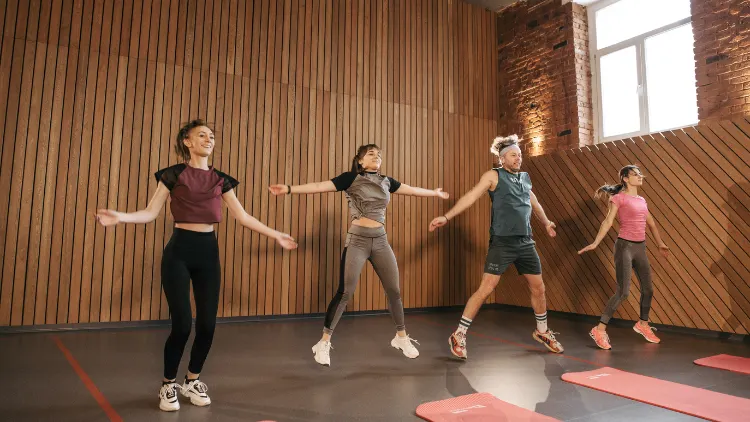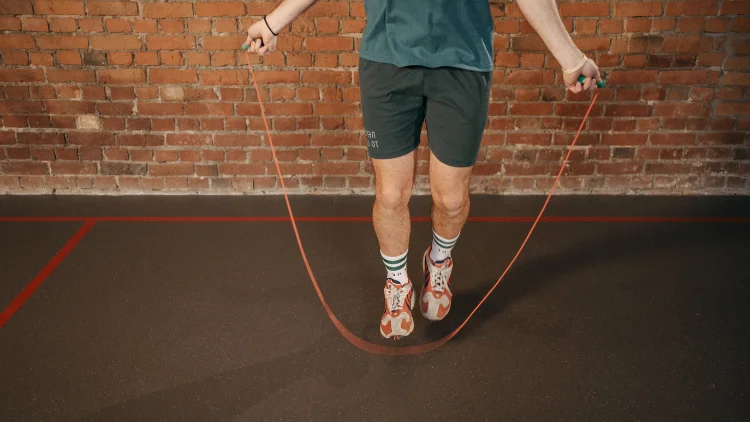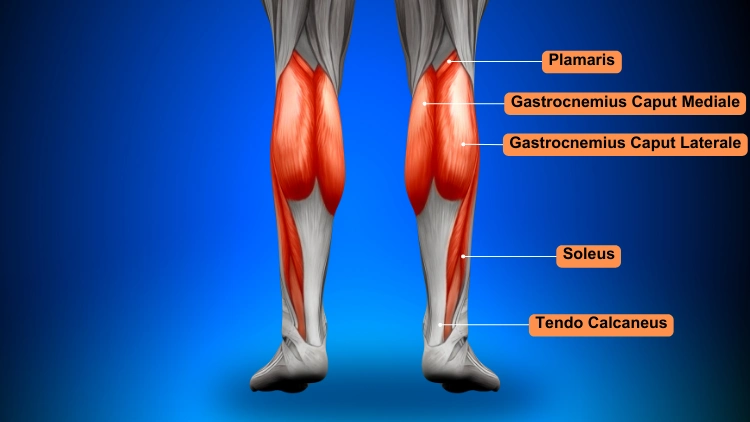
When comparing jumping jacks vs jump rope there is a wide range of things to look at from the many benefits to the variety of muscles used.1 While there’s countless differences between jumping jacks and jump ropes, they both offer a unique strength-building, cardio workout that can be beneficial for people of all ages.
While jumping jacks and jump rope are commonly used to warm up, they both make an excellent workout on their own. For this reason, we’ll review each muscle worked for both jumping jacks and jump ropes, how many calories each burns, the benefits of each, alternatives and variations, as well as a workout program to get you going!
Benefits of Jumping Jacks vs Jump Rope & When To Use Each
Both jumping jacks and jump rope offer a variety of benefits. Jumping jacks are particularly advantageous for several reasons.
They can be used as a quick and efficient warm-up. No equipment is needed and one can do jumping jacks anywhere making it an excellent on-the-go exercise.
It’s also possible to adjust the intensity based on fitness levels. One could increase the speed of the jumping jacks or for a high-intensity workout, they could do star jumps.
For a low-impact exercise, one could sidestep each leg one at a time and move arms in the jumping jack motion so no jumping is required.
Jumping rope is an excellent and very versatile exercise that comes with a range of benefits. It is very easy to adjust the intensity of the workout by jumping slower for a low-impact workout and doing double unders, when a jump rope goes under your feet two times for one jump, for a high-intensity workout.
Furthermore, jumping rope can be a great way to exercise for any age. Research has shown jump rope is safe and effective for adults over 50.2
Additionally, when looking at 10-12-year-old boys using jumping rope as a means of exercise it was found that there was a positive impact on strength and speed, and adding jumping rope into the physical fitness curriculum could potentially positively contribute to the development of a child’s motor skills.3
Both jumping jacks and jump rope are easy, efficient exercises that can be done anywhere with little to no equipment. They can be a great exercise for those wanting a quick, calorie-burning workout.
Jumping Jacks Benefits & When To Use
Here are 13 of the top benefits of jumping jacks and when they could be a good exercise for one to do.

Source: Pavel Danilyuk via Pexels4
- Can Be Done Anywhere: One of the most notable benefits of jumping jacks is they can be done anywhere and no equipment is needed!
- Great Warm-Up Exercise: Jumping jacks engage the whole body making them a great, quick way to warm up before working out.
- Efficient Cardio For All Fitness Levels: Jumping jacks are an exercise that can be modified based on personal needs and is easy to pick up for beginners. To enhance the benefits of jumping jacks, here are some weight loss diet tips for beginners.
- Build Leg Strength: Every muscle in the lower body is engaged while doing jumping jacks. Specifically, the calves, quads, hamstrings, and glutes are targeted.
- Could Potentially Limit Risk of Osteopenia: Exercises that require explosive jumping such as jumping jacks will increase bone density and strength and may reduce the risk of osteopenia.5
- Improve Mobility: Because each joint used during a jumping jack is both fully extended and flexed mobility will improve with regular jumping jacks.
- Improve Hip Strength: The lateral training involved with doing jumping jacks increases hip strength thus also reducing the possibility of injury.6
- Offers a Full Body Workout: Jumping jacks work out one’s entire body with the jumping, leg movement, and arm movement required.
- Great for Heart Health: Jumping jacks are an efficient cardio workout that in turn positively impacts one’s cardiovascular health.
- Burns A Lot of Calories: According to MyFitnessPal, one can burn approximately 10 calories per 1 minute by doing jumping jacks. So for just 15 minutes of work, it’s possible to burn 150 calories! There are a lot of free calorie-counting apps and a few to compare are Lose It vs MyFitnessPal.
- Improve Coordination: Jumping jacks does require a lot of coordination because of all the different muscles involved in the exercise. After practice and regular use of jumping jacks, coordination will be improved.
- Good For One’s Mental Health: Jumping jacks, alongside most other exercises, reduce the stress hormone, cortisol to help limit stress. With jumping jacks being something one can do anywhere they are a great “on the go” stress reliever.
- Boost Metabolism: Being such an efficient cardio workout, jumping jacks have the ability to boost one’s metabolism and burn fat.
Jump Rope Benefits & When To Use
Jumping rope can be very beneficial to use for a variety of reasons.
If someone is looking to improve their cardio and endurance, mental health, or coordination jumping rope may be the exercise for you. It is versatile and easy to do. Here are the top 13 benefits of jump roping.
Here are some of the top jump rope benefits:

Source: Pavel Danilyuk via Pexels7
- Boosting Heart Health: Jumping rope could be beneficial to improving heart health. A study showed that jumping rope had a positive correlation with reducing cardiovascular heart disease risk factors.8
- Efficient Cardio For All Fitness Levels: Jumping rope is a very easy, efficient cardio workout. It is quick to pick up and one can easily adjust the speed and intensity.
- Improves Coordination: When jumping rope one has to coordinate moving the rope with their arms and hand and jumping at a rhythmic pace. It does require a lot of coordination and may be difficult at first. Starting slow and steady can allow one the time to learn the movement and see improvement as time goes on.
- Improves Balance: Alongside improving coordination, jumping rope is great for balance.9 Due to the balance skills needed to perform this exercise, it could be difficult for beginners at first but balance will dramatically improve while jump roping and in other exercises.
- Can Build Bone Density: Regular jump roping can lead to improved bone mineral density.10
- Can Be Relaxing: While jumping rope can be a high-intensity workout, the motion can also become very rhythmic which could be relaxing for some.
- Improves Jump Height: Many athletes are looking to improve their vertical jump, the repetitive exercise of the calves and ankles while jump roping will strengthen those muscles thus improving jump height.
- Improving Speed: Furthermore, the increase in strength of the lower body will also lead to faster running speeds.11
- Fun, Enjoyable Exercise: Research has shown the many benefits of finding an exercise one enjoys and jumping rope may be just that for some!12
- Calorie Burner: One can burn between 100 and 300 calories during a 20-minute jumping rope session. This number will vary significantly based on one’s height, weight, and the intensity of the jumping rope session.
- Enhances Brain Function: Jumping rope has been shown to improve one’s attention and cognitive performance.13
- Improve Breathing: As one builds up cardio endurance while jumping rope, lung capacity will be enhanced. One will quickly be able to notice the differences in other daily activities.
- Versatile and Can Be Done Anywhere: A jump rope is easy to transport which makes this exercise easy to do anywhere.
Does Jumping Jacks or Jump Rope Burn More Calories?
Jumping jacks vs jump rope are both efficient and easy-to-do workouts that have the potential to burn a lot of calories but jumping rope will burn slightly more calories than jumping jacks. According to MyFitnessPal, for someone who weighs 150 pounds, it’s possible to burn about 10 calories per 1 minute of jumping jacks and about 15 calories per 1 minute of jumping rope.
The number of calories burned will vary based on a variety of factors such as one’s body weight, age, gender, duration, and intensity.
To measure intensity levels the metabolic equivalent of a task (MET) is used.14 MET is a simple way to determine the intensity of an exercise and will have a large impact on the number of calories burned.
What Are the Muscles Worked in Jumping Jacks vs Jump Rope
Both jumping jacks and jump rope will work a variety of muscles. Both are considered full-body exercises and will target specific muscles.
While both exercises target all of the lower body muscles, jump roping will also work more of the upper body compared to jumping jacks. Keep on reading to see the top 13 muscles used for jump roping and doing jumping jacks.
Jumping Jacks Muscles Used
While jumping jacks are a fantastic full-body workout specific muscles are targeted. Here are the top 13 muscles that will really benefit from jumping jacks.
1- Calves: With any jumping exercises, the calves are being worked. The calf muscle is especially important as it aids with standing and supporting the lower body while walking and running.

Source: decade3d via Canva.com15
2- Core Muscles: The core is essential when doing exercises that require balance and stability like jumping jacks. The abs are engaged during this exercise, making it an excellent choice for those looking to reduce upper belly fat.
3- Abductor Hip Muscle: The abductor’s muscle is the side of the upper leg near the glute. These muscles are crucial in balance and posture. The lateral motion of jumping jacks strengthens these muscles. There are also additional exercises for strong and supple hips.
4- Adductor Hip Muscle: These muscles run along one’s inner thigh. These muscles are important to stabilize one’s hip while walking and exercising. Like the abductor, the lateral movement required of jumping jacks these muscles are targeted.
5- Glutes: The glute muscles are important in lateral movements and rotating one’s leg. The glutes are targeted with jumping exercises.
6- Quadriceps: The upper front part of one’s leg is the quad muscles. These muscles form more mass than any other muscle in the body. They are used for a variety of movements such as kicking, walking, and running.
7- Hamstrings: The upper back part of the legs are the hamstrings. The hamstrings are crucial in mobility and play an important part in walking and running. These muscles are also susceptible to injury so having strong hamstrings is beneficial and could help prevent injury.
8- Plantar Flexors: These are the muscles of the foot that are crucial for walking and running. These muscles allow one to flex their feet and stand on their toes.
9- Shoulders: Due to the motion required while doing jumping jacks, one’s shoulders are specifically targeted and worked out. Shoulders are crucial for a lot of basic, life tasks such as cooking and cleaning. Like the hamstrings, they are also prone to injury so increasing shoulder strength is important. Shoulder protocol to build strength and mobility can be helpful to follow as well.
10- Tricep: The tricep is the muscle at the back of one’s arm above the elbow and its primary function is extending the elbow.
11- Bicep: The bicep is the muscle at the front of one’s arm above the elbow and is used for pulling and lifting motions. While bad bicep genetics can have an impact on building muscle, adding bicep exercises into a workout routine can be beneficial for anyone.
12- Upper Chest: The upper chest or pectoral muscles help one move their arms inward. These muscles are targeted while performing jumping jacks. These muscles help stabilize your shoulder which can be invaluable in preventing injury to the shoulder.
13- Heart: With this cardio exercise, one’s heart muscle is worked. Strengthening one’s heart has been shown effective in reducing the risk of heart disease.
What Are the Jump Rope Muscle Groups? What Are the Jump Rope Muscles Used?
While jump rope will target similar muscles to jumping jacks, more of the upper body is engaged while jumping rope because of the need to move the rope. Similar to jumping jacks, jumping rope provides an effective full-body workout. Here are the top 13 muscles targeted during a jump rope session.
- Calves: With any jumping exercises, the calves are being worked. The calf muscle is especially important as it aids with standing and supporting the lower body while walking and running.
- Quadriceps: The quads are engaged while jumping rope and being the largest muscle per mass these are crucial in daily leg movement.
- Hamstrings: The hamstrings are also important in running, walking, and other leg movements. Being more prone to injury, strong hamstrings are important.
- Glutes: The glutes are important for twisting the legs and supporting the body while running and standing.
- Oblique Ab Muscle: The obliques are the abdominal muscles on each side of the body. These muscles are common ones someone wanting to lose weight wants to target. There are many tips and tricks to help you lose weight in just 7 days. They are important in moving the body from side to side and twisting.
- Entire Core: The entire core muscles are engaged during the stabilizing exercise of jump rope. Balance is necessary for jumping rope and the core is crucial in balance.
- Biceps: While moving the rope the biceps are targeted.
- Triceps: Alongside working out the biceps, the triceps are also engaged while moving the rope.
- Forearms: Unlike jumping jacks, the forearms which are the muscles between the elbow and hand are engaged while moving the rope. The forearms help with hand movement. Stronger forearms can lead to a strong grip which can be helpful in carrying and lifting items while working out and in daily life.
- Traps: The movement made with a jump rope targets the upper back or trapezoid muscles. Back muscles are crucial in many different motions such as sitting, standing and turning.
- Upper Chest: The pectoral or upper chest muscles are also engaged while turning the jump rope.
- Shoulders: The shoulders are targeted while jump roping. While these muscles are prone to injury, strengthening these muscles can be helpful to prevent potential injury.
- Heart: Cardio exercises are an efficient way to improve heart health and strength.
Calories Burned Jump Roping Vs Jumping Jacks
When looking at the calories burned doing jumping jacks vs jump rope, jumping rope will burn slightly more calories. Jumping rope burns about 15 calories per minute of work whereas jumping jacks is closer to 10 calories per minute of exercise.
Despite that, both jumping jacks and jump rope are efficient and easy-to-do exercises that could burn a lot of calories.
Calories Burned From Doing Jumping Jacks
Weight (150lbs)
- Calories Burned After 15 Minutes of Jumping Jacks: 138 calories
- Calories Burned After 30 Minutes of Jumping Jacks: 275 calories
Weight (175lbs)
- Calories Burned After 15 Minutes of Jumping Jacks: 160 calories
- Calories Burned After 30 Minutes of Jumping Jacks: 321 calories
Weight (190lbs)
- Calories Burned After 15 Minutes of Jumping Jacks: 174 calories
- Calories Burned After 30 Minutes of Jumping Jacks: 348 calories
Weight (220lbs)
- Calories Burned After 15 Minutes of Jumping Jacks: 202 calories
- Calories Burned After 30 Minutes of Jumping Jacks: 403 calories
Calories Burned From Doing Jump Rope
Weight (150lbs)
- Calories Burned After 15 Minutes of Jump Rope: 211 calories
- Calories Burned After 30 Minutes of Jump Rope: 422 calories
Weight (175lbs)
- Calories Burned After 15 Minutes of Jump Rope: 246 calories
- Calories Burned After 30 Minutes of Jump Rope: 492 calories
Weight (190lbs)
- Calories Burned After 15 Minutes of Jump Rope: 267 calories
- Calories Burned After 30 Minutes of Jump Rope: 534 calories
Weight (220lbs)
- Calories Burned After 15 Minutes of Jump Rope: 309 calories
- Calories Burned After 30 Minutes of Jump Rope: 618 calories
Jump Rope Alternatives & Variations
Jump rope is a very high-impact workout and those with injury or limited physical fitness should listen to one’s body and the advice of a medical professional when engaging in jumping rope. It’s also crucial to ensure proper recovery and sufficient sleep, as many people question whether 6 hours of rest is adequate for muscle growth.

Source: MART PRODUCTION from Pexels16
There are a few different ways to make jump roping more of a high-intense workout such as double-unders and using a weighted jump rope. Jumping rope can also be modified to be a low-impact workout by adjusting the speed of the rope.
Weighted Jump Rope Benefits
Most weighted jump ropes weigh around 1.5 pounds but there are some that can weigh as much as 5 pounds. It’s important to really listen to one’s body and current strength levels when determining if a weighted jump rope would be beneficial to use.
Additionally, starting with low weight and building on it would be a sustainable approach.
Here are some of the top-weighted jump rope benefits:
- It’s a great cardio and strength-training exercise.
- The upper body muscles are worked more intensely with turning a weighted rope vs a normal jump rope.
- There is a more elevated and intense core and lower back workout.
It is important to keep in mind that using a weighted jump rope creates a higher impact exercise and could put more stress and pressure on one’s joints.
Double-Unders
Another way to make the jumping rope exercise more intense is by doing double-unders. This requires quicker movement of a jump rope making it pass under the feet two times for each jump.
Double unders require very quick movement and are a high-intense exercise. The biggest benefit to double-unders is training explosiveness and a high-intensity workout.
Jumping Jacks Alternatives & Variations
Jumping jacks can also be a high-impact exercise due to the amount of jumping required. It is possible to adjust this exercise to make it more intense and low impact with limited or no jumping required.
Star Jumps
For a high-intensity workout, one could instead do star jumps. These are done by jumping into the air with both legs and arms spread wide, making a star shape with the body.
These take jumping jacks to a whole new level and will quickly get one’s heart rate up and the body warm.
These can be great warm-up exercises or used as part of a cardio workout. Star jumps will also activate the same muscles used when doing jump jacks and with the jump off the ground, the lower body is worked out more.
Modified Jumping Jack with No Jumping
For those who are looking for a lower-intensity jumping jack option that will still get the whole body moving but does not require jumping, this modified jumping jack could be great to try out. To do this motion one will still move the arms as they would with the normal jumping jack but instead of jumping the legs out to the side at the same side, they will alternate the legs.
For example, putting the right leg out to the side then bringing it in, and then putting the left leg out to the side.
This exercise will still work out the upper and lower body and can be an efficient cardio exercise but does not require the same high impact as a normal jumping jack.
Workout Program Incorporating Jumping Jacks & Jump Rope
To create a workout program using jumping jacks and jump rope there are a variety of approaches one could take. Both jumping jacks and jump rope are excellent warm-up exercises that also serve as efficient standalone workouts, capable of burning a significant number of calories in a short period.
For a quick HIIT workout using jumping jacks, follow the jump rope workout routine below 2-3x per week at first:
- 5 x 20-50 (1 minute of rest). Or, 5 sets of 20-50 jumping jacks with 1 minute rest period in-between sets.
- Optional: One final set with AMRAP (as many reps as possible), or as many jumping jacks as you can do at once and without a break.
Note, the amount of jumping jacks can be doubled of halved depending on a person’s level of fitness. The 1 minute rest periods can also be doubled or halved.
On the other hand, we’ll detail jump ropes in minutes since beginners may only be able to do a few before tripping over the rope…and that’s perfectly okay since it takes awhile to get use to the timing.
For a quick jump rope routine, try out this jump rope routine:
- 5-10 x 1 minute (1 minute of rest). Or, 5-10 sets of 1 minute sessions with a minute of rest in-between sets.
- Optional: For those are able to do a full minute of jump ropes without tripping, end the session with single leg jump ropes with 2 sets on each leg, for 30 second intervals, and just 30 seconds of rest.
Again this can be modified but .5 or x2 depending on fitness levels. You can even combine the jump rope and jumping jack exercises into one day if one alone is too easy.
All in all, both jumping jacks and jump rope offer a unique and different cardio exercise that may be more exciting and fun compared to other typical cardio workouts. When comparing jumping jacks vs jump rope there are countless benefits to both and it’s important to figure out what works best for you!
Frequently Asked Questions
How Long Do I Need To Jump Rope Each Day To Lose Weight?
For someone who weighs 175 pounds, they would be able to burn close to 500 calories during a 30-minute jump rope routine. To lose 1 pound of fat one would need to burn about 3,500 calories so it would be possible to lose weight by jump roping for 30 minutes per day 7 times a week.
How Long Should I Do Jumping Jacks To Lose Weight?
Someone who weighs 175 pounds can burn about 300 calories during a 30-minute workout so to lose weight only doing jumping jacks one would need to exercise for closer to 1 hour 7 times a week to lose 1 pound a week.
Which Is Easier To Do 100 Of: Jumping Jacks or Jump Rope?
It will be faster and easier to do 100 skips of jump roping vs 100 jumping jacks.
Which Builds More Muscle: Jumping Jacks vs Jump Rope?
While both jumping jacks and jump rope work a lot of different muscles, overall jump roping will target more of the upper body alongside the lower body and since the weight of the rope can be increased, jump rope has a chance to actually build muscle unlike jumping jacks where weight can’t be added.
References
1“Free Photo | Tattooed and muscular athlete doing jumping jacks isolated on white brick wall next to black pull bar.” Freepik. Accessed 19 April 2023. <https://www.freepik.com/free-photo/tattooed-muscular-athlete-doing-jumping-jacks-isolated-white-brick-wall-black-pull-bar_11829411.htm>
2Moran, J., Ramirez-Campillo, R., & Granacher, U. (2018). Effects of Jumping Exercise on Muscular Power in Older Adults: A Meta-Analysis. Sports Med, 48(12), 2843-2857. <https://pubmed.ncbi.nlm.nih.gov/30341594/>
3Eler, N., & Acar, H. (2018). The Effects of the Rope Jump Training Program in Physical Education Lessons on Strength, Speed and VO2 max in Children. Universal Journal of Educational Research, 6(2), 340-345. <https://files.eric.ed.gov/fulltext/EJ1170647.pdf>
4Pavel Danilyuk. “People in the Fitness Center Doing Jumping Jacks.” Canva. Accessed 14 April 2023. <https://www.canva.com/photos/MAERzGAZkLo-people-in-the-fitness-center-doing-jumping-jacks/>
5Umemura, Y. (2017). [The effects of jumping exercise on bones]. Clin Calcium. <https://pubmed.ncbi.nlm.nih.gov/28017947/>
6Taniguchi, Y. (1997). Lateral specificity in resistance training: the effect of bilateral and unilateral training. Eur J Appl Physiol Occup Physiol. <https://pubmed.ncbi.nlm.nih.gov/28445230/>
7Pavel Danilyuk. “Person Doing Jump Rope.” Canva. Accessed 14 April 2023. <https://www.canva.com/photos/MAERzNXh1q8-person-doing-jump-rope/>
8Sung, K.-D., Pekas, E. J., Scott, S. D., Son, W.-M., & Park, S.-Y. (2019). The effects of a 12-week jump rope exercise program on abdominal adiposity, vasoactive substances, inflammation, and vascular function in adolescent girls with prehypertension. Eur J Appl Physiol, 119(2), 577-585 <https://pubmed.ncbi.nlm.nih.gov/30554386/>
9Trecroci, A., Cavaggioni, L., Caccia, R., & Alberti, G. (2015). Jump Rope Training: Balance and Motor Coordination in Preadolescent Soccer Players. J Sports Sci Med, 14(4), 792-798. <https://www.ncbi.nlm.nih.gov/pmc/articles/PMC4657422/>
10Tucker, L. A., Strong, J. E., LeCheminant, J. D., & Bailey, B. W. (2015). Effect of two jumping programs on hip bone mineral density in premenopausal women: a randomized controlled trial. Am J Heath Promot. <https://pubmed.ncbi.nlm.nih.gov/24460005/>
11Ramirez-Campillo, R., Andrade, D. C., Garcia-Pinillos, F., Negra, Y., Boullosa, D., & Moran, J. (2021). Effects of jump training on physical fitness and athletic performance in endurance runners: A meta-analysis. J Sports Sci. <https://pubmed.ncbi.nlm.nih.gov/33956587/>
12Hagberg, L. A., Lindahl, B., & Hellenius, M. L. (2009). Importance of enjoyment when promoting physical exercise. Scand J Med Sci Sports. <https://pubmed.ncbi.nlm.nih.gov/18694433/>
13Yamashita, M., & Yamamoto, T. (2021). Impact of Long-Rope Jumping on Monoamine and Attention in Young Adults. Brain Sci. <https://www.ncbi.nlm.nih.gov/pmc/articles/PMC8534060/>
14Staying Active | The Nutrition Source | Harvard T.H. Chan School of Public Health. (2022). Harvard T.H. Chan School of Public Health. <https://www.hsph.harvard.edu/nutritionsource/staying-active/>
15decade3d. “Calves – Anatomy Muscles.” Canva. Accessed 14 April 2023. <https://www.canva.com/photos/MAC_U2yFahk-calves-anatomy-muscles/>
16MART PRODUCTION. “Photo of Jump Rope and Water Bottle on Yoga Mat.” Canva. Accessed 14 April 2023. <https://www.canva.com/photos/MAEfd7HawNk-photo-of-jump-rope-and-water-bottle-on-yoga-mat/>